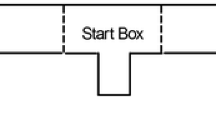Abstract
Eighteen, 23-hr, food deprived, self-stimulating rats were divided into two groups. One group received 20 EBS pulses as a reward for a correct response in a T-maze while a second group received food reward. The subjects learned the correct T-maze response for food reinforcement during 5 days of 10 massed trials per day, but failed to show any evidence of learning for EBS “reinforcement”, either within sessions or over days, using measures of errors or running speeds. Such an exception raises serious question as to whether EBS is a transituational reinforcer or not, and if not, its mechanism of influences upon behavior.
Similar content being viewed by others
References
BULL, J. A. & COLLINS, T. B. 1965. A simple procedure for making small electrodes. Amer. J. Psychol., 78, 676.
DEUTSCH, J. A. 1960. The structural basis of behavior. Cambridge, England: Cambridge University Press.
GALLISTEL, C. R. 1964. Electrical self-stimulation and its theoretical implications. Psychol. Bull., 61, 23–34.
MacCORQUODALE, K. & MEEHL, P. E. 1951. On the elimination of cul entries without obvious reinforcement. J. comp. physiol Psychol., 44, 367–371.
MILLER, N. E, COONS, E. E., LEWIS, M, & JENSEN, D. D. 1961. Electrode holders in chronic preparations: B. A simple technique for use with the rat. In SHEER, D. E. (Ed.) Electrical stimulation of the brain. Austin: Univer. Texas Press, pp. 51–54.
NEWMAN, Bertha L. 1961. Behavioral effects of electrical self-stimulation of the septal area and related structures in the rat. J. comp. physiol Psychol., 54, 340–346.
OLDS, J. 1956. Runway and maze behavior controlled by basomedial forebrain stimulation in the rat. J. comp. physiol. Psychol., 49, 507–512.
OLDS, J. 1960. Differentiation of reward systems in the brain by self-stimulation techniques. In Ramey, Estelle R., & O’doherty, D. S. (Eds.), Electrical studies on the unanethetized brain. New York: Hoeber, p. 42.
OLDS, J., & OLDS, MARIANNE. 1965. Drives, rewards, and the brain. In Newcomb, T. M. (Ed.), New Directions in Psychology II. New York: Holt, Rinehart & Winston, pp. 329–410.
OLDS, J., TRAVIS, R. P., & SCHWING, R. C. 1960. Topographical organization of hypothalamic self-stimulation functions. J. comp. physiol Psychol. 53, 23–32.
SCOTT, J. W. 1967. Brain stimulation reinforcement with distributed practice: effects of electrode locus, previous experience, and stimulus intensity. J. Comp. physiol. Psychol., 63, 175–183.
SEWARD, J. P., UYEDA, A., & OLDS, J. 1960. Reinforcing effect of brain stimulation on runway performance as a function of interval between trials. J. comp. physiol. Psychol., 53, 224–228.
WETZEL, Mary C. 1963. Self-stimulation aftereffects and runway performance in the rat. J. comp. physiol. Psychol., 56, 673–678.
Author information
Authors and Affiliations
Additional information
The author would like to express his appreciation to Thomas B. Collins, Jr., for aid and encouragement received during the conduct of this experiment and to J. Bruce Overmier for aid and encouragement in the preparation of the manuscript. This research was conducted at Central Washington State College.
Rights and permissions
About this article
Cite this article
Bull, J. Failure of Apparently Rewarding Electrical Brain Stimulation to Serve as a Reinforcer for T-Maze Learning. Psychol Rec 18, 81–88 (1968). https://doi.org/10.1007/BF03393746
Published:
Issue Date:
DOI: https://doi.org/10.1007/BF03393746




